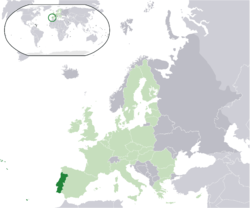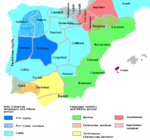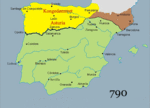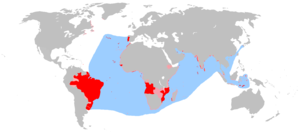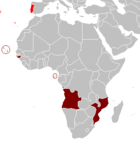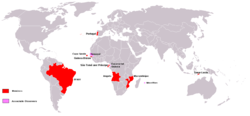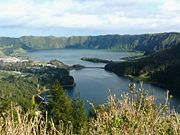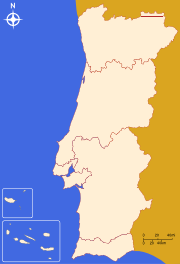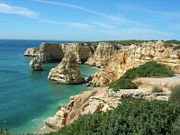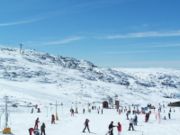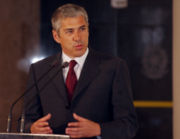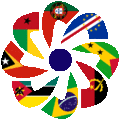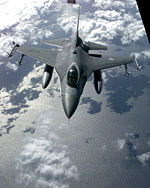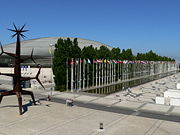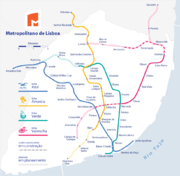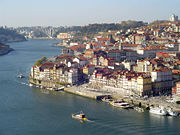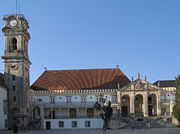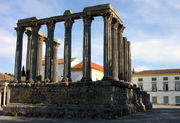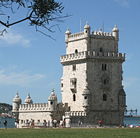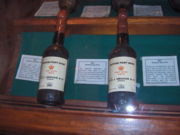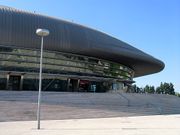Portugal
2008/9 Schools Wikipedia Selection. Related subjects: Europe; European Countries
| República Portuguesa Portuguese Republic
|
||||||
|---|---|---|---|---|---|---|
|
||||||
| Anthem: " A Portuguesa" |
||||||
|
Location of Portugal (dark green)
– on the European continent (light green & dark grey) |
||||||
| Capital (and largest city) |
Lisbon5 |
|||||
| Official languages | Portuguese1 | |||||
| Recognised regional languages | Mirandese | |||||
| Demonym | Portuguese | |||||
| Government | Parliamentary republic6 | |||||
| - | President | Aníbal Cavaco Silva | ||||
| - | Prime Minister | José Sócrates | ||||
| Formation | Conventional date for Independence is 1139 | |||||
| - | Founding | 868 | ||||
| - | Re-founding | 1095 | ||||
| - | De facto sovereignty | June 24, 1128 | ||||
| - | Kingdom | 25 July 1139 | ||||
| - | Recognized | 5 October 1143 | ||||
| - | Papal Recognition | 1179 | ||||
| EU accession | 1 January 1986 | |||||
| Area | ||||||
| - | Total | 92,345 km² ( 110th) 35,645 sq mi |
||||
| - | Water (%) | 0.5 | ||||
| Population | ||||||
| - | July 2007 estimate | 10,848,692 ( 75th) | ||||
| - | 2001 census | 10,148,259 | ||||
| - | Density | 114/km² ( 87th) 295/sq mi |
||||
| GDP ( PPP) | 2007 (IMF) estimate | |||||
| - | Total | $230.6 billion ( 43rd) | ||||
| - | Per capita | $23,464 (2007) ( 34th) | ||||
| GDP (nominal) | 2007 (IMF) estimate | |||||
| - | Total | $223.3 billion ( 36th) | ||||
| - | Per capita | $21,019 ( 32nd) | ||||
| HDI (2005) | ▼ 0.897 (high) ( 29th) | |||||
| Currency | Euro ( €)² ( EUR) |
|||||
| Time zone | WET³ | |||||
| - | Summer ( DST) | WEST ( UTC0) | ||||
| Internet TLD | .pt4 | |||||
| Calling code | +351 | |||||
| 1 | Mirandese, spoken in some villages of the municipality of Miranda do Douro, was officially recognized in 1999 (Lei n.° 7/99 de 29 de Janeiro), since then awarding an official right-of-use Mirandese to the linguistic minority it is concerned. The Portuguese Sign Language is also recognized. | |||||
| 2 | Before 1999: Portuguese escudo. | |||||
| 3 | Azores: UTC-1; UTC in summer. | |||||
| 4 | The .eu domain is also used, as it is shared with other European Union member states. | |||||
| 5 | Coimbra was the capital of the country from 1139 to about 1260. | |||||
| 6 | The present form of the Government was established by the Carnation Revolution of April 25, 1974, that ended the authoritarian regime of the Estado Novo. | |||||
Portugal, officially the Portuguese Republic (Portuguese: República Portuguesa), is a country on the Iberian Peninsula. Located in southwestern Europe, Portugal is the westernmost country of mainland Europe and is bordered by the Atlantic Ocean to the west and south and by Spain to the north and east. The Atlantic archipelagos of the Azores and Madeira are also part of Portugal.
The land within the borders of today's Portuguese Republic has been continuously settled since prehistoric times. Some of the earliest civilizations include Lusitanians and Celtic societies. Incorporation into the Roman Republic dominions took place in the 2nd century BC. The region was ruled and colonized by Germanic peoples, such as the Suebi and the Visigoths, from the 5th to the 8th century. From this era, some vestiges of the Alans were also found. The Muslim Moors arrived in the early 8th century and conquered the Christian Germanic kingdoms, eventually occupying most of the Iberian Peninsula. In the early 1100s, during the Christian Reconquista, Portugal appeared as a kingdom independent of its neighbour, the Kingdom of León and Galicia. In a little over a century, in 1249, Portugal would establish almost its entire modern-day borders by conquering territory from the Moors.
During the 15th and 16th centuries, with a global empire that included possessions in Africa, Asia and South America, Portugal was one of the world's major economic, political, and cultural powers. In the 17th century, the Portuguese Restoration War between Portugal and Spain ended the sixty year period of the Iberian Union (1580-1640). In the 19th century, armed conflict with French and Spanish invading forces and the loss of its largest territorial possession abroad, Brazil, disrupted political stability and potential economic growth. After the Portuguese Colonial War and the Carnation Revolution coup d'état in 1974, the ruling regime was deposed in Lisbon and the country handed over its last overseas provinces in Africa. Portugal's last overseas territory, Macau, was handed over to China in 1999.
Portugal is a developed country, has a high Human Development Index and is among the world's 20 highest rated countries in terms of quality of life, although having the lowest GDP per capita of Western European countries. It is a member of the European Union (since 1986) and the United Nations (since 1955); as well as a founding member of the Organisation for Economic Co-operation and Development (OECD), North Atlantic Treaty Organization, Comunidade dos Países de Língua Portuguesa ( Community of Portuguese Language Countries, CPLP), European Union's Eurozone, and is also a Schengen state.
History
The early history of Portugal, whose name derives from the Roman name Portus Cale, is shared with the rest of the Iberian Peninsula. The region was settled by Pre- Celts and Celts, giving origin to peoples like the Gallaeci, Lusitanians, Celtici and Cynetes, visited by Phoenicians and Carthaginians, incorporated in the Roman Republic dominions (as Lusitania in 138 BC), settled again by Suevi, Buri, and Visigoths, and conquered by Moors. Other minor influences include some 5th century vestiges of Alan settlement, which were found in Alenquer, Coimbra and even Lisbon. In 868, during the Reconquista (by which Christians reconquered the Iberian peninsula from the Muslim and Moorish domination), the First County of Portugal was formed. A victory over the Muslims at Ourique in 1139 is traditionally taken as the occasion when Portugal is transformed from a county ( County of Portugal as a fief of the Kingdom of León and Castile) into an independent kingdom.
On June 24, 1128, the Battle of São Mamede occurred near Guimarães. At the Battle of São Mamede, Afonso Henriques, Count of Portugal, defeated his mother, Countess Teresa, and her lover, Fernão Peres de Trava, in battle - thereby establishing himself as sole leader. Afonso Henriques officially declared Portugal's independence when he proclaimed himself king of Portugal on July 25, 1139, after the Battle of Ourique, he was recognized as such in 1143 by Afonso VII, king of León and Castile, and in 1179 by Pope Alexander III.
Afonso Henriques and his successors, aided by military monastic orders, pushed southward to drive out the Moors, as the size of Portugal covered about half of its present area. In 1249, this Reconquista ended with the capture of the Algarve on the southern coast, giving Portugal its present day borders, with minor exceptions.
In 1373, Portugal made an alliance with England, which is the longest-standing alliance in the world.
In 1383, the king of Castile, husband of the daughter of the Portuguese king who had died without a male heir, claimed his throne. An ensuing popular revolt led to the 1383-1385 Crisis. A faction of petty noblemen and commoners, led by John of Aviz (later John I), seconded by General Nuno Álvares Pereira defeated the Castilians in the Battle of Aljubarrota. This celebrated battle is still a symbol of glory and the struggle for independence from neighboring Spain.
In the following decades, Portugal spearheaded the exploration of the world and undertook the Age of Discovery. Prince Henry the Navigator, son of King João I, became the main sponsor and patron of this endeavor.
In 1415, Portugal gained the first of its overseas colonies when a fleet conquered Ceuta, a prosperous Islamic trade centre in North Africa. There followed the first discoveries in the Atlantic: Madeira and the Azores, which led to the first colonization movements.
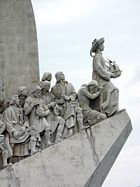
Throughout the 15th century, Portuguese explorers sailed the coast of Africa, establishing trading posts for several common types of tradable commodities at the time, ranging from gold to slaves, as they looked for a route to India and its spices, which were coveted in Europe. In 1498, Vasco da Gama finally reached India and brought economic prosperity to Portugal and its then population of one million residents.
In 1500, Pedro Álvares Cabral, en route to India, discovered Brazil and claimed it for Portugal. Ten years later, Afonso de Albuquerque conquered Goa, in India, Ormuz in the Persian Strait, and Malacca in what is now a state in Malaysia. Thus, the Portuguese empire held dominion over commerce in the Indian Ocean and South Atlantic. The Portuguese sailors set out to reach Eastern Asia by sailing eastward from Europe landing in such places like Taiwan, Japan, the island of Timor, and it may also have been Portuguese sailors that were the first Europeans to discover Australia.
Portugal's independence was interrupted between 1580 and 1640. Because the heirless King Sebastian died in battle in Morocco, Philip II of Spain claimed his throne and so became Philip I of Portugal. Although Portugal did not lose its formal independence, it was governed by the same monarch who governed Spain, briefly forming a union of kingdoms, as a personal union; in 1640, John IV spearheaded an uprising backed by disgruntled nobles and was proclaimed king. The Portuguese Restoration War between Portugal and Spain on the aftermath of the 1640 revolt, ended the sixty-year period of the Iberian Union under the House of Habsburg. This was the beginning of the House of Braganza, which was to reign in Portugal until 1910. On 1 November 1755, Lisbon, the largest city and capital of the Portuguese Empire, was strongly shaken by an earthquake which killed between 60,000 and 90,000 people and destroyed eighty-five percent of the city.
By this time, however, the Portuguese empire was already under attack from other countries, specifically Britain and the Netherlands. Portugal began a slow but inexorable decline until the 20th century. This decline was hastened by the independence in 1822 of the country's largest colonial possession, Brazil.
At the height of European colonialism in the 19th century, Portugal had lost its territory in South America and all but a few bases in Asia. During this phase, Portuguese colonialism focused on expanding its outposts in Africa into nation-sized territories to compete with other European powers there. Portuguese territories eventually included the modern nations of Cape Verde, São Tomé and Príncipe, Guinea-Bissau, Angola, and Mozambique.
In 1910, a revolution deposed the Portuguese monarchy, but chaos continued and considerable economic problems were aggravated by the military intervention in the First World War, which led to a military coup d'état in 1926. This in turn led to the establishment of the right-wing dictatorship of the Estado Novo under António de Oliveira Salazar.
In December 1961, the Portuguese army was involved in armed action in its colony of Portuguese India against an Indian invasion. The operations resulted in the defeat of the isolated and relatively small Portuguese defense force which was not able to resist a much larger enemy. The outcome was the loss of the Portuguese territories in the Indian subcontinent.
Also in the early 1960s, independence movements in the Portuguese overseas provinces of Angola, Mozambique, and Portuguese Guinea, in Africa, resulted in the Portuguese Colonial War (1961-1974). In 1974, a bloodless left-wing military coup in Lisbon, known as the Carnation Revolution, led the way for a modern democracy as well as the independence of the last colonies in Africa shortly after. However, Portugal's last overseas territory, Macau (Asia), was not handed over to the People's Republic of China until as late as 1999.
Portugal was a founding member of NATO, OECD and EFTA. In 1986, Portugal joined the European Union (then the European Economic Community). It is also a co-founder of the Community of Portuguese Language Countries.
Administrative divisions
Portugal has an administrative structure of 308 municipalities (Portuguese singular/plural: concelho/concelhos), which are subdivided into more than 4,000 parishes (freguesia/freguesias). Municipalities are grouped for administrative purposes into superior units. For continental Portugal the municipalities are gathered in 18 Districts, while the Islands have a Regional Government directly above them. Thus, the largest unit of classification is the one established since 1976 into either mainland Portugal (Portugal Continental) or the autonomous regions of Portugal ( Azores and Madeira).
The European Union's system of Nomenclature of Territorial Units for Statistics is also used. According to this system, Portugal is divided into 7 regions ( Alentejo, Algarve, Açores, Centro, Lisboa, Madeira, and Norte), which are subdivided into 30 subregions.
Geography and climate
The climate can be classified as Mediterranean type csa in the south and csb in the north, according to the Köppen climate classification. Portugal is one of the warmest European countries, the annual temperature averages in mainland Portugal are 13 °C (55 °F) in the north and 18 °C (64 °F) in the south. The Madeira and Azores Atlantic archipelagos have a narrower temperature range. Generally, spring and summer are sunny, whereas autumn and winter are rainy and windy. Extreme temperatures occur in Northeastern parts of the country in winter (where they may fall to -15 °C) and Southeastern parts in summer (where they can soar up to 45 °C). Sea coastal areas are milder, temperatures varying between -2 °C on the coldest winter mornings and 40 °C on the hottest summer afternoons. Absolute extremes registered so far have been -23 °C in Serra da Estrela and 48 °C in the Alentejo region.
Mainland Portugal is split by its main river, the Tagus. The northern landscape is mountainous in the interior areas, with plateaus indented by river valleys. The south, between the Tagus and the Algarve (the Alentejo), features mostly rolling plains and a climate somewhat warmer and drier than in the cooler and rainier north. The Algarve, separated from the Alentejo by mountains, enjoys a Mediterranean climate much like southern Spain. Snow falls occasionally (on some cold winter days) in the northern interior of the country, from October to May. However, it is a very rare event in the south. The coast registers snow usually once in five or six years.
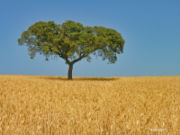
The islands of the Azores are located in the Mid-Atlantic Ridge whilst the Madeira islands were formed by the activity of an in-plate hotspot, much like the Hawaiian archipelago. Some islands have had volcanic activity as recently as 1957. Portugal's highest point is Mount Pico on Pico Island. It is an ancient volcano measuring 2,351 m (7,713 ft). Mainland Portugal's highest point is Serra da Estrela, measuring 1993 m (6,558 ft).
Portugal's Exclusive Economic Zone, a seazone over which the Portuguese have special rights over the exploration and use of marine resources, has 1,727,408 km². This is the 3rd largest Exclusive Economic Zone of the European Union and the 11th in the world.
Conservation areas of Portugal include one national park (Parque Nacional), 12 natural parks (Parque Natural), 9 natural reserves (Reserva Natural), 5 natural monuments (Monumento Natural), and 7 protected landscapes (Paisagem Protegida), ranging from the Parque Nacional da Peneda-Gerês to the Parque Natural da Serra da Estrela to the Paul de Arzila. Climate and geographical diversity shaped the Portuguese Flora. There are almost 2,800 autochthonous species. Due to economical reasons the pines trees (especially the Pinus pinaster and Pinus pinea species), the chestnut tree ( Castanea sativa), the cork oak ( Quercus suber), and the eucalyptus ( Eucalyptus globulus) are very widespread. Fauna is diverse and includes foxes, badgers, genets, feral cats, hares, weasels, and polecats. Portugal is an important stop over place for migratory birds.
Government and politics
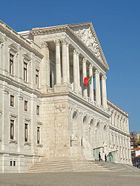
Portugal is a democratic republic ruled by the constitution of 1976 with Lisbon, the nation's largest city, as its capital. The four main governing components are the president of the republic, the assembly of the republic, the government, and the courts. The constitution grants the division or separation of powers among legislative, executive, and judicial branches. Portugal like most European countries has no state religion, making it a secular state.
The president, who is elected to a five-year term, has a supervising, non-executive role. The current President is Aníbal Cavaco Silva. The Assembly of the Republic is a unicameral parliament composed of 230 deputies elected for four-year terms. The government is headed by the prime minister (currently José Sócrates), who chooses the Council of Ministers, comprising all the ministers and the respective state secretaries.
The national and regional governments (those of Azores and Madeira autonomous regions), and the Portuguese parliament, are dominated by two political parties, the Socialist Party and the Social Democratic Party. Minority parties Unitarian Democratic Coalition ( Portuguese Communist Party plus Ecologist Party "The Greens"), Bloco de Esquerda (Left Bloc) and CDS-PP (People's Party) are also represented in the parliament and local governments.
The courts are organized into categories, including judicial, administrative, and fiscal. The supreme courts are the courts of last appeal. A thirteen-member constitutional court oversees the constitutionality of legislation.
Foreign relations
Portugal is a founding member of NATO (1949), OECD (1961) and EFTA (1960); it left the latter in 1986 to join the European Union. In 1996 it co-founded the Community of Portuguese Language Countries (CPLP). It has a friendship alliance and dual citizenship treaty with Brazil. Portugal is part of the world's oldest active alliance through its treaty with the United Kingdom.
The only international dispute concerns the municipality of Olivença. Under Portuguese sovereignty since 1297, the municipality of Olivença was ceded to Spain under the Treaty of Badajoz in 1801, after the War of the Oranges. Portugal claimed it back in 1815 under the Treaty of Vienna. Nevertheless, bilateral diplomatic relations between the two neighbouring countries are cordial, as well as within the European Union.
Military
The armed forces have three branches: Army, Navy, and Air Force. The military of Portugal serves primarily as a self-defense force whose mission is to protect the territorial integrity of the country and providing humanitarian assistance and security at home and abroad.
Since the early 2000s, compulsory military service is no longer practised. The changes also turned the forces' focus towards professional military engagements. The age for voluntary recruitment is set at 18. In the 20th century, Portugal engaged in two major military interventions: the First Great War and the Portuguese Colonial War (1961-1974).
Portugal has participated in peacekeeping missions in East Timor, Bosnia, Kosovo, Afghanistan, Iraq ( Nasiriyah), and Lebanon. The Portuguese Military's Rapid Reaction Brigade, a combined force of the nations elite Paratroopers, Special Operations Troops Centre, and Commandos, is a special elite fighting force.
The Guarda Nacional Republicana (GNR) is a police force under the authority of the military, its soldiers are subject to military law and organization. GNR has provided detachments for participation in international operations in Iraq and East Timor.
Economy
Portugal's economy is based on services and industry such as software and automotive. Business services have overtaken more traditional industries such as textiles, clothing, footwear, cork and wood products and beverages (wine, beer, juice, soft drinks). The country has increased its role in the automotive, mold-making and software sectors. Services, particularly tourism, are playing an increasingly important role. Portugal's European Union (EU) funding will be cut by 10%, to 22.5 billion euros, during the 2007-2013 period. EU expansion into eastern Europe has erased Portugal's past competitive advantage and relative low labor costs. Portugal's economic development model has been changing from one based on public consumption and public investment to one focused on exports, private investment, and development of the high-tech sector. At present, Portugal is exporting more technology than it imports.
Portugal joined the European Union in 1986 and started a process of modernization within the framework of a stable environment. It has achieved a healthy level of growth. Successive governments have implemented reforms and privatized many state-controlled firms and liberalized key areas of the economy. Portugal was one of the founding countries of the euro in 1999, and therefore is integrated into the Eurozone.
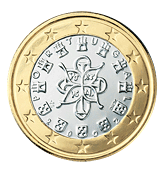
Major industries include oil refineries, automotive, cement production, pulp and paper industry, textile, footwear, furniture, and cork (of which Portugal is the world's leading producer). Manufacturing accounts for 33% of exports. Portugal is the world's fifth-largest producer of tungsten, and the world's eighth-largest producer of wine. Agriculture and Fishing (see Portugal EEZ) no longer represents the bulk of the economy. However, Portugal has a strong tradition in the fisheries sector and is one of the countries with the highest fish consumption per capita. Portuguese wines, namely Port Wine (named after the country's second largest city, Porto) and Madeira Wine (named after Madeira Island), are exported worldwide. Tourism is also important, especially in mainland Portugal's southernmost region of the Algarve and in the Atlantic Madeira archipelago.
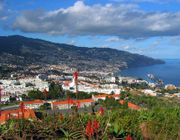
The Global Competitiveness Report for 2005, published by the World Economic Forum, places Portugal on the 22nd position, ahead of countries such as Spain, Ireland, France, Belgium and Hong Kong . This represents an increase of two places from the 2004 ranking. Portugal was ranked 20th on the Technology index and 15th on the Public Institutions index.
Research about standard of living by the Economist Intelligence Unit's quality of life survey places Portugal as the country with the 19th-best quality of life in the world, ahead of other economically and technologically advanced countries like France, Germany, the United Kingdom and South Korea. This is despite the fact that Portugal has the lowest per capita GDP in Western Europe and among the lowest in the European Union.
Caixa Geral de Depósitos, EDP, Galp, Millennium bcp, Portugal Telecom and Sonae are among the largest corporations of Portugal by both number of employees and net income.
The major stock exchange is the Euronext Lisbon which is part of the NYSE Euronext, the first global stock exchange. The PSI-20 is Portugal's most selective and widely known stock index.
Energy, transportation, communications, water supply and sanitation
In 2006 the world's largest solar power plant began operating in the nation's sunny south while the world's first commercial wave power farm opened in October 2006 in the Norte region. As of 2006, 55% of electricity production was from coal and fuel power plants. The other 40% was produced by hydroelectrics and 5% by wind energy. The government is channeling $38,000,000,000 into developing renewable energy sources over the next five years.
Portugal wants renewable energy sources like solar, wind and wave power to account for nearly half of the electricity consumed in the country by 2010. "This new goal will place Portugal in the frontline of renewable energy and make it, along with Austria and Sweden, one of the three nations that most invest in this sector", Prime Minister José Sócrates said.
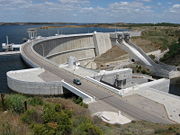
Transportation was seen as a priority in the 1990s, pushed by the growing use of automobiles and industrialization. The country has a 68,732 km (42,708 mi) network of roads, of which almost 3,000 km (1,864 mi) are part of a 44 motorways system.
The two principal metropolitan areas have subway systems: Lisbon Metro and Metro Sul do Tejo in Lisbon Metropolitan Area and Porto Metro in Porto, each with more than 35 km (22 mi) of lines. Construction of a high-speed TGV line connecting Porto with Lisbon and Lisbon with Madrid will begin in 2008; it will replace the Pendolinos.
Lisbon's geographical position makes it a stopover point for many foreign airlines at airports all over the country. The government decided to build a new airport outside Lisbon, in Alcochete, to replace Lisbon's Portela airport. Currently, the most important airports are in Lisbon, Faro, Porto, Funchal ( Madeira), and Ponta Delgada ( Azores).
Portugal has one of the highest mobile phone penetration rates in the world (the number of operative mobile phones already exceeds the population). This network also provides wireless mobile Internet connections as well, and covers the entire territory. As of October 2006, 36.8% of households had high-speed Internet services and 78% of companies had Internet access. Most Portuguese watch television through cable (June 2004: 73.6% of households). Paid Internet connections are available at many cafés, as well as many post offices. One can also surf on the Internet at hotels, conference centres and shopping centres, where special areas are reserved for this purpose. Free internet access is also available to Portuguese residents at "Espaços de Internet" across the country.
Portugal has also modernized its water supply and sanitation system, in particular by increasing the rate of wastewater treated with support from EU subsidies to 80%. The country has also established a modern institutional and legal framework for the water and sanitation sector, including an autonomous regulatory agency, a national asset holding company called Águas de Portugal and a number of multi-municipal utilities. This replaced an institutionally fragemented sector structure, under which the country's 308 municipalities - many of them very small - had exclusive responsibility for water and sanitation.
Demographics
The country is fairly homogeneous linguistically and religiously. Native Portuguese are ethnically a combination of pre-Celts, Celts, and the Lusitanians, along with some other minor contributions by Phoenicians, Romans, Germanic ( Visigoths, Suebi, Buri), Alans, some Jews and Moors (mostly Berbers and some Arabs).
In the 2001 census, the population was 10,356,117, of which 52% was female, 48% was male. Portugal, long a country of emigration, has now become a country of net immigration, and not just from the former Asian and African colonies; by the end of 2003, legal immigrants represented about 5% of the population, and the largest communities were from Brazil, Ukraine, Romania, Cape Verde, Angola, Russia, Guinea-Bissau and Moldova with other immigrants from parts of Latin America, China and Eastern Europe. The great majority of Portuguese are Roman Catholic, though a large percentage consider themselves non-practising, especially in urban lands.
The most populous cities are Lisbon, Porto, Vila Nova de Gaia, Amadora, Braga, Coimbra, Almada, Funchal, Setúbal and Guimarães. There are seven Greater Metropolitan Areas ( GAMs): Algarve, Aveiro, Coimbra, Lisbon, Minho, Porto and Viseu.
Education, science and technology
The educational system is divided into preschool (for those under age 6), basic education (9 years, in three stages, compulsory), secondary education (3 years), and higher education (university and polytechnic).
Total adult literacy rate is 95%. Portuguese primary school enrollments are close to 100%. About 20% of college-age students attend one of the country's higher education institutions (compared with 50% in the United States). In addition to being a key destination for international students, Portugal is also among the top places of origin for international students. All higher education students, both domestic and international, totaled 380,937 in 2005.
Portuguese universities have existed since 1290. The oldest Portuguese university was first established in Lisbon before moving to Coimbra. Universities are usually organized into faculties. Institutes and schools are also common designations for autonomous subdivisions of Portuguese higher education institutions, and are always used in the polytechnical system. The Bologna process has been adopted since 2006 by Portuguese universities and polytechnical institutes.
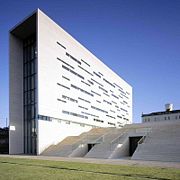
Scientific and technological research activities in Portugal are mainly conducted within a network of R&D units belonging to public universities and state-managed autonomous research institutions like the INETI - Instituto Nacional de Engenharia, Tecnologia e Inovação. The funding of this research system is mainly conducted under the authority of the Ministry of Science, Technology and Higher Education. The largest R&D units of the public universities by number of publications which achieved significant international recognition, include biosciences research institutions like the Instituto de Medicina Molecular, the Centre for Neuroscience and Cell Biology, the IPATIMUP, and the Instituto de Biologia Molecular e Celular. Among the private universities, notable research centers include the Facial Emotion Expression Lab. Internationally notable state-supported research centres in other fields include the International Iberian Nanotechnology Laboratory, a joint research effort between Portugal and Spain. Among the largest non-state-run research institutions in Portugal are the Instituto Gulbenkian de Ciência and the Champalimaud Foundation which yearly awards one of the highest monetary prizes of any science prize in the world. A number of both national and multinational high-tech and industrial companies, are also responsible for research and development projects. One of the oldest learned societies of Portugal is the Sciences Academy of Lisbon.
Portugal made agreements with several European scientific organizations aiming at full membership. These include the European Space Agency (ESA), the European Laboratory for Particle Physics (CERN), ITER, and the European Southern Observatory (ESO). Portugal has entered into cooperation agreements with MIT (USA) and other North American institutions in order to further develop and increase the effectiveness of Portuguese higher education and research.
Law
The Portuguese legal system is part of the civil law legal system, also called the continental family legal system. Until the end of the 19th century, French law was the main influence. Since then the major influence has been German law. The main laws include the Constitution (1976, as amended), the Civil Code (1966, as amended) and the Penal Code (1982, as amended). Other relevant laws are the Commercial Code (1888, as amended) and the Civil Procedure Code (1961, as amended). Portuguese law applied in the former colonies and territories and continues to be the major influence for those countries.
Religion
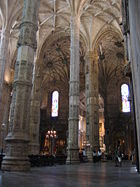
Church and state were formally separated during the Portuguese First Republic (1910-26), a separation reiterated in the Portuguese Constitution of 1976. Portugal is a secular state. Other than the Constitution, the two most important documents relating to religious freedom are the 2001 Religious Freedom Act and the 1940 Concordata (as amended in 1971) between Portugal and the Holy See.
Portuguese society is overwhelmingly Roman Catholic. 84% of the population are nominally Roman Catholic, but only about 20% attend mass and take the sacraments regularly. A larger number wish to be baptized, married in the church, and receive last rites.
Many Portuguese holidays, festivals and traditions have a Christian origin or connotation. Although relations between the Portuguese state and the Roman Catholic Church were generally amiable and stable since the earliest years of the Portuguese nation, their relative power fluctuated. In the 13th and 14th centuries, the church enjoyed both riches and power stemming from its role in the reconquest and its close identification with early Portuguese nationalism and the foundation of the Portuguese educational system, including the first university. The growth of the Portuguese overseas empire made its missionaries important agents of colonization with important roles of evangelization and teaching in all inhabited continents.
Culture
Portugal has developed a specific culture while being influenced by various civilizations that have crossed the Mediterranean and the European continent, or were introduced when it played an active role during the Age of Discovery.
Portuguese literature, one of the earliest Western literatures, developed through text and song. Until 1350, the Portuguese-Galician troubadours spread their literary influence to most of the Iberian Peninsula. Gil Vicente (ca. 1465 - ca. 1536), was one of the founders of both Portuguese and Spanish dramatic traditions. Adventurer and poet Luís de Camões (ca. 1524-1580) wrote the epic poem The Lusiads, with Virgil's Aeneid as his main influence. Modern Portuguese poetry is rooted in neoclassic and contemporary styles, as exemplified by Fernando Pessoa (1888–1935). Modern Portuguese literature is represented by authors such as Almeida Garrett, Camilo Castelo Branco, Eça de Queiroz, Sophia de Mello Breyner Andresen, and António Lobo Antunes. Particularly popular and distinguished is José Saramago, winner of the 1998 Nobel Prize for literature.
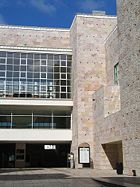
Portuguese music encompasses a wide variety of genres. The most renowned is fado, a melancholy urban music, usually associated with the Portuguese guitar and saudade, or longing. Coimbra fado, a unique type of fado, is also noteworthy. Internationally notable performers include Amália Rodrigues, Carlos Paredes, José Afonso, Mariza, Carlos do Carmo, Mísia, and Madredeus. One of the most notable Portuguese musical groups outside the country, and specially in Germany, is the goth-metal band Moonspell. In addition to fado and folk, the Portuguese listen to pop and other types of modern music, particularly from North America and the United Kingdom, as well as a wide range of Portuguese and Brazilian artists and bands. Bands with international recognition include Blasted Mechanism and The Gift, both of which were nominated for an MTV Music Award. Portugal has several summer music festivals, such as Festival Sudoeste in Zambujeira do Mar, Festival de Paredes de Coura in Paredes de Coura, Festival Vilar de Mouros near Caminha, and Rock in Rio Lisboa and Super Bock Super Rock in Lisbon. Out of the summer season, Portugal has a large number of festivals, designed more to an urban audience, like Flowfest or Hip Hop Porto. Furthermore, one of the largest international Goa trance festivals takes place in northern Portugal every two years, and the student festivals of Queima das Fitas are major events in a number of cities across Portugal.
In the Classical music domain, Portugal is represented by names as the pianist Maria João Pires, the violinist Carlos Damas, the operatic baritone Jorge Chaminé, and in the past by the great cellist Guilhermina Suggia. Notable composers include Luís de Freitas Branco and his student Joly Braga Santos.
It has also a rich history as far as painting is concerned. The first well-known painters date back to the XV century – like Nuno Gonçalves - were part of the Gothic painting period. José Malhoa, known for his work Fado, and Columbano Bordalo Pinheiro (who painted the portraits of Teófilo Braga and Antero de Quental) were both references in naturalist painting.
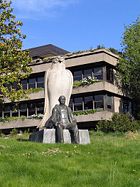
The 20th century saw the arrival of Modernism, and along with it came the most prominent Portuguese painters: Amadeo de Souza-Cardoso, who was heavily influenced by French painters, particularly by the Delaunays. Among his best known works is Canção Popular a Russa e o Fígaro. Another great modernist painter/writer was Almada Negreiros, friend to the poet Fernando Pessoa, who painted his (Pessoa’s) portrait. He was deeply influenced by both Cubist and Futurist trends. Prominent international figures in visual arts nowadays include painters Vieira da Silva, Júlio Pomar, and Paula Rego. Traditional architecture is distinctive. Modern Portugal has given the world renowned architects like Eduardo Souto de Moura, Álvaro Siza Vieira and Gonçalo Byrne. Internally, Tomás Taveira is also noteworthy.
Since the 1990s, Portugal has increased the number of public cultural facilities, in addition to the Calouste Gulbenkian Foundation established in 1956 in Lisbon. These include the Belém Cultural Centre in Lisbon, Serralves Foundation and the Casa da Música, both in Porto, as well as new public cultural facilities like municipal libraries and concert halls which were built or renovated in many municipalities across the country.
Cuisine
Portuguese cuisine is diverse. The Portuguese consume a lot of dry cod ( bacalhau in Portuguese), for which there are hundreds of recipes. There are more than enough bacalhau dishes for each day of the year. Two other popular fish recipes are grilled sardines and caldeirada. Typical Portuguese meat recipes, that may take beef, pork, lamb, or chicken, include feijoada, cozido à portuguesa, frango de churrasco, and carne de porco à alentejana.
Typical fast food dishes include the francesinha from Porto, and bifanas (grilled pork), prego (grilled beef) or leitão (piglet) sandwiches which are well known around the country. The Portuguese art of pastry has its origins in ancient recipes of which pastéis de Belém (or pastéis de nata) originally from Lisbon, and ovos-moles from Aveiro are good examples. Portuguese cuisine is very diverse, with different regions having their own traditional dishes. The Portuguese have a cult for good food and throughout the country there are myriads of good restaurants and small typical tascas.
Portuguese wines have deserved international recognition since the times of the Roman Empire, which associated Portugal with their God Bacchus. Today the country is known by wine lovers and its wines have won several international prizes. Some of the best Portuguese wines are: Vinho Verde, Vinho Alvarinho, Vinho do Douro, Vinho do Alentejo, Vinho do Dão, Vinho da Bairrada and the sweet: Port Wine, Madeira Wine and the Moscatel from Setúbal and Favaios. Port Wine is well known around the world and the most widely known wine type in the world. The Douro wine region is the oldest in the world.
Sports and games
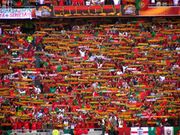
Football is the most known, loved and played sport. The legendary Eusébio is still a major symbol of Portuguese football history and Luís Figo and Cristiano Ronaldo are among the numerous examples of other world-class footballers born in Portugal and noted worldwide.
The Portuguese national teams, have titles in the FIFA World Youth Championship and in the UEFA youth championships. The main national team - Selecção Nacional - finished second in Euro 2004, reached the third place in the 1966 FIFA World Cup, and reached the fourth place in the 2006 FIFA World Cup, their best results in major competitions to date.
F.C. Porto, S.L. Benfica and Sporting C.P. are the largest sports clubs by popularity and in terms of trophies won, often known as "os três grandes" ( "the big three"). They have a number of titles won in the European UEFA club competitions, were present in many finals and have been regular contenders in the last stages almost every season. Other than football, many Portuguese sports clubs, including the "big three", compete in several other sports events with a varying level of success and popularity.
Portugal has a successful rink hockey team, with 15 world titles and 20 european titles, making it the country with the most wins in both competitions. The most successful Portuguese rink hockey clubs in the history of European championships are F.C. Porto, S.L. Benfica, Sporting CP, and Óquei de Barcelos.
The national rugby union team made a dramatic qualification into the 2007 Rugby World Cup and become the first all amateur team to qualify for the World Cup since the dawn of the professional era. The Portuguese national team of rugby sevens has performed well, becoming one of the strongest teams in Europe, and proved their status as European champions in several occasions.
Rui Silva, in men's athletics, has won several gold, silver and bronze medals in the European, World and Olympic Games competitions. Francis Obikwelu in the 100 m and the 200 m, had silver in the 2004 Summer Olympics. Naide Gomes in pentathlon and long jump, is another Portuguese elite athlete, which led to a gold medal in the 2008 IAAF World Indoor Championships' long jump competition. In the triathlon, Vanessa Fernandes, has won a large number of medals and major competitions across the world and in 2007 became the world champion both in Triathlon and Duathlon. In judo, Telma Monteiro is European champion in the women's under-52 kg category. Nelson Évora is world champion in triple jump.
Cycling, with Volta a Portugal being the most important race, is also a popular sports event and include professional cycling teams such as S.L. Benfica, Boavista, Clube de Ciclismo de Tavira, and União Ciclista da Maia. Noted Portuguese cyclists include, among others, names as Joaquim Agostinho, Marco Chagas, José Azevedo and Sérgio Paulinho (an olympic medalist in Athens).
The country has also achieved notable performances in sports like fencing, surfing, windsurf, kitesurf, kayaking, sailing and shooting, among others. The paralympic athletes have also conquered many medals in sports like swimming, boccia and wrestling. Portugal has its own original martial art, jogo do pau, in which the fighters use staffs to confront one or several opponents.
International rankings
Political and economic rankings
- Political freedom ratings - Free; political rights and civil liberties both rated 1 (the highest score available)
- Press freedom - 8th freest, at 2.00
- GDP per capita - 34th highest, at I$22,677
- Human Development Index - 29th highest, at 0.897
- Income Equality - 59th most equal, at 38.5 ( Gini Index)
- Unemployment rate - 98th lowest, at 8.00%
- Corruption - 28th least corrupt, at 6.5 on index
- Economic Freedom - 30th freest, at 2.29 on index
Health rankings
- Fertility rate- 188th most fertile, at 1.48 per woman
- Birth rate - 167th most births, at 10.50 per 1000 people
- Death rate - 52nd highest death rate, at 10.60 per 1000 people
- Life Expectancy - 49th highest, at 77.87 years
- Suicide Rate - 42nd highest suicide rate, at 18.9 for males and 4.9 for females
- HIV/AIDS rate - 73rd most cases, at 0.40%
Other rankings
- Global Peace Index - 7th highest (2008), out of 121 countries
- CO2 emissions - 68th highest emissions, at 5.63 tonnes per capita
- Electricity Consumption - 44th highest consumption of electricity, at 44,010,000,000 kWh
- Broadband uptake - 21st highest uptake in OECD, at 11.5%
- Beer consumption - 22nd highest, at 59.6 litres per capita
- Wine consumption - 4th highest, at 53.0 litres per capita
- Wine production - 7th highest, at 953 million litres (not long ago ranked 4th with twice the output)
Facts and figures
- Official date format: YYYY/MM/DD (ex. 2006/09/08)
- Common date format: DD/MM/YYYY (ex. 06/09/2006), dates are written out as DD de MM de YYYY (ex. 18 de Agosto de 2005)
- Decimal separator is a comma: 123,45
- Thousands are officially separated by a space — 10 000 — although the point is widely used — 10.000
- The euro sign is commonly placed either before or after the amount, with the separator either a comma or a point: 10,95 € - € 10,95 - € 10.95 - 10.95 €


